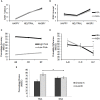Biases in probabilistic category learning in relation to social anxiety
- PMID: 26347685
- PMCID: PMC4538570
- DOI: 10.3389/fpsyg.2015.01218
Biases in probabilistic category learning in relation to social anxiety
Abstract
Instrumental learning paradigms are rarely employed to investigate the mechanisms underlying acquired fear responses in social anxiety. Here, we adapted a probabilistic category learning paradigm to assess information processing biases as a function of the degree of social anxiety traits in a sample of healthy individuals without a diagnosis of social phobia. Participants were presented with three pairs of neutral faces with differing probabilistic accuracy contingencies (A/B: 80/20, C/D: 70/30, E/F: 60/40). Upon making their choice, negative and positive feedback was conveyed using angry and happy faces, respectively. The highly socially anxious group showed a strong tendency to be more accurate at learning the probability contingency associated with the most ambiguous stimulus pair (E/F: 60/40). Moreover, when pairing the most positively reinforced stimulus or the most negatively reinforced stimulus with all the other stimuli in a test phase, the highly socially anxious group avoided the most negatively reinforced stimulus significantly more than the control group. The results are discussed with reference to avoidance learning and hypersensitivity to negative socially evaluative information associated with social anxiety.
Keywords: information processing biases; instrumental learning; positive versus negative feedback; probabilistic learning; reinforcement learning; social anxiety.
Figures


References
LinkOut - more resources
Full Text Sources
Other Literature Sources

